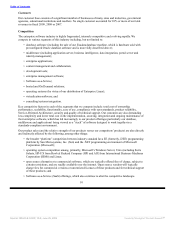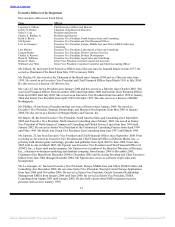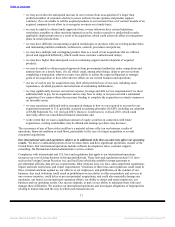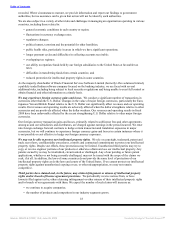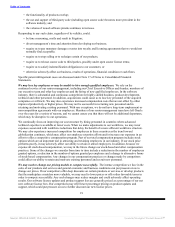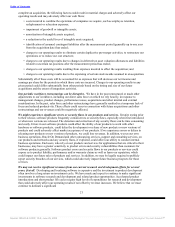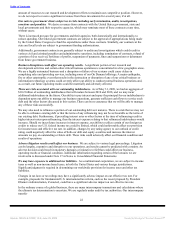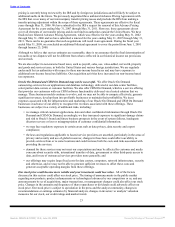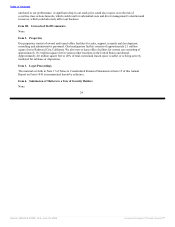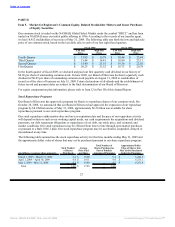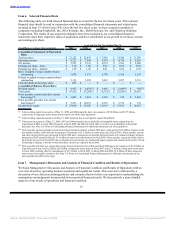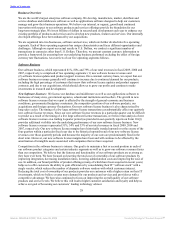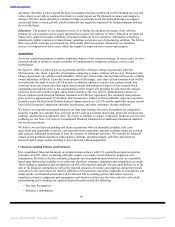Oracle 2008 Annual Report Download - page 25
Download and view the complete annual report
Please find page 25 of the 2008 Oracle annual report below. You can navigate through the pages in the report by either clicking on the pages listed below, or by using the keyword search tool below to find specific information within the annual report.
Table of Contents
Any broad-based change to our prices and pricing policies could cause new software license and services
revenues to decline or be delayed as our sales force implements and our customers adjust to the new pricing
policies. Some of our competitors may bundle software products for promotional purposes or as a long-term
pricing strategy or provide guarantees of prices and product implementations. These practices could, over
time, significantly constrain the prices that we can charge for certain of our products. If we do not adapt our
pricing models to reflect changes in customer use of our products or changes in customer demand, our new
software license revenues could decrease. Additionally, increased distribution of applications through
application service providers, including software-as-a-service (SaaS) providers, may reduce the average price
for our products or adversely affect other sales of our products, reducing new software license revenues
unless we can offset price reductions with volume increases. The increase in open source software distribution
may also cause us to change our pricing models.
We may be unable to compete effectively within the highly competitive software industry. Many vendors
develop and market databases, internet application server products, application development tools, business
applications, collaboration products and business intelligence products that compete with our offerings. In
addition, several companies offer business process outsourcing (BPO) and SaaS as competitive alternatives to
buying software, and customer interest in BPO and SaaS solutions is increasing. Some of these competitors
have greater financial or technical resources than we do. Our competitors that offer business applications and
middleware products may influence a customer’s purchasing decision for the underlying database in an effort
to persuade potential customers not to acquire our products. We could lose customers if our competitors
introduce new competitive products, add new functionality, acquire competitive products, reduce prices or
form strategic alliances with other companies. Vendors that offer BPO or SaaS solutions may persuade our
customers not to purchase our products. We may also face increasing competition from open source software
initiatives, in which competitors may provide software and intellectual property for free. Existing or new
competitors could gain sales opportunities or customers at our expense.
Disruptions of our indirect sales channel could affect our future operating results. Our indirect channel
network is comprised primarily of resellers, system integrators/implementers, consultants, education
providers, internet service providers, network integrators and independent software vendors. Our relationships
with these channel participants are important elements of our marketing and sales efforts. Our financial results
could be adversely affected if our contracts with channel participants were terminated, if our relationships
with channel participants were to deteriorate, if any of our competitors enter into strategic relationships with
or acquire a significant channel participant or if the financial condition of our channel participants were to
weaken. There can be no assurance that we will be successful in maintaining, expanding or developing our
relationships with channel participants. If we are not successful, we may lose sales opportunities, customers
and revenues.
Charges to earnings resulting from acquisitions may adversely affect our operating results. In fiscal 2010,
we will adopt FASB Statement No. 141 (revised 2007), Business Combinations and FASB Staff Position
(FSP) FAS 141(R)-1 Accounting for Assets Acquired and Liabilities Assumed in a Business Combinations
That Arise from Contingencies. Accounting for our acquisitions pursuant to Statement 141(R) is significantly
different than how we have historically accounted for our acquisitions under existing accounting principles
and these differences could materially impact our results of operations or financial position. The more
significant differences include how we account for restructuring liabilities associated with an acquisition,
costs incurred to effect the acquisition, changes in estimates of income tax valuation allowances and liabilities
for uncertain tax positions associated with an acquisition, and how we reflect goodwill adjustments in
comparative financial statements, among others. A more thorough discussion of our accounting for these and
other items is presented in the “Critical Accounting Policies and Estimates” section of Management’s
Discussion and Analysis of Financial Condition and Results of Operations (Item 7).
For any business combination that is consummated pursuant to Statement 141(R), we will recognize the
identifiable assets acquired, the liabilities assumed, and any non-controlling interest in acquired companies
generally at their acquisition date fair values and, in each case, separately from goodwill. Goodwill as of the
acquisition date is measured as the excess amount of consideration transferred, which is also generally
measured at fair value, and the net of the acquisition date amounts of the identifiable assets acquired and the
liabilities assumed. Our estimates of fair value are based upon assumptions believed to be reasonable but
which are inherently uncertain. After we
20
Source: ORACLE CORP, 10-K, June 29, 2009 Powered by Morningstar® Document Research℠


